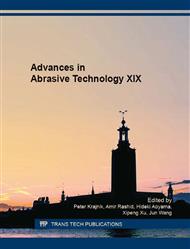[1]
S.Y. Hong, I. Markus, W. c. Jeong, New cooling approach and tool life improvement in cryogenic machining of titanium alloy Ti-6Al-4V, International Journal of Machine Tools & Manufacture, 41 (2001) 16.
DOI: 10.1016/s0890-6955(01)00041-4
Google Scholar
[2]
E.O. Ezugwu, Z.M. Wang, Titanium alloys and their machinability - a review, Journal of Materials Processing Technology, 68 (1997) 12.
Google Scholar
[3]
A. Thakur, S. Gangopadhyay, State-of-the-art in surface integrity in machining of nickel-based super alloys, International Journal of Machine Tools and Manufacture, 100 (2016) 25-54.
DOI: 10.1016/j.ijmachtools.2015.10.001
Google Scholar
[4]
E.O. Ezugwu, Key improvements in the machining of difficult-to-cut aerospace superalloys, International Journal of Machine Tools and Manufacture, 45 (2005) 1353-1367.
DOI: 10.1016/j.ijmachtools.2005.02.003
Google Scholar
[5]
D. Setti, M.K. Sinha, S. Ghosh, P. Venkateswara Rao, Performance evaluation of Ti–6Al–4V grinding using chip formation and coefficient of friction under the influence of nanofluids, International Journal of Machine Tools and Manufacture, 88 (2015).
DOI: 10.1016/j.ijmachtools.2014.10.005
Google Scholar
[6]
R.E.I.G.S.R.H.S.T.W. Liao, <Off-line multiresponse optimization of electrochemical surface grinding by a multi-objective programming method. pdf>, International Journal of Machine Tools and Manufacture, 32 (1991) 17.
DOI: 10.1016/0890-6955(92)90013-7
Google Scholar
[7]
V. Zwilling; M. Aucouturier; E. Darque-Ceretti, <Anodic oxidation of titanium and TA6V alloy in chromic media. An electrochemical approach. pdf>, Electrochimica Acta, 45 (1999) 9.
DOI: 10.1016/s0013-4686(99)00283-2
Google Scholar
[8]
A.F.T.J. Atkinson, Overcut in pulsed electrochemical grinding, Engineering, Manufacturing, 214 (2000 ) 10.
Google Scholar
[9]
S. Zaborski, M. Łupak, D. Poroś, Wear of cathode in abrasive electrochemical grinding of hardly machined materials, Journal of Materials Processing Technology, 149 (2004) 414-418.
DOI: 10.1016/j.jmatprotec.2004.02.015
Google Scholar
[10]
P. Sapre, A. Mall, S.S. Joshi, Analysis of Electrolytic Flow Effects in Micro-Electrochemical Grinding, Journal of Manufacturing Science and Engineering, 135 (2013) 011012.
DOI: 10.1115/1.4023266
Google Scholar
[11]
A.B. Suvadeep Roy, Simul Banerjee, Analysis of effect of voltage on surface texture in electrochemical grinding by autocorrelation function, Tribology International, 40 (2007) 6.
DOI: 10.1016/j.triboint.2007.03.008
Google Scholar
[12]
D.Z. K.P. Rajurkar, J.A. McGeough, J. Kozak, A. De Silva, New Developments in Electro-Chemical Machining, CIRP Annals - Manufacturing Technology, 48 (1999) 12.
DOI: 10.1016/s0007-8506(07)63235-1
Google Scholar


